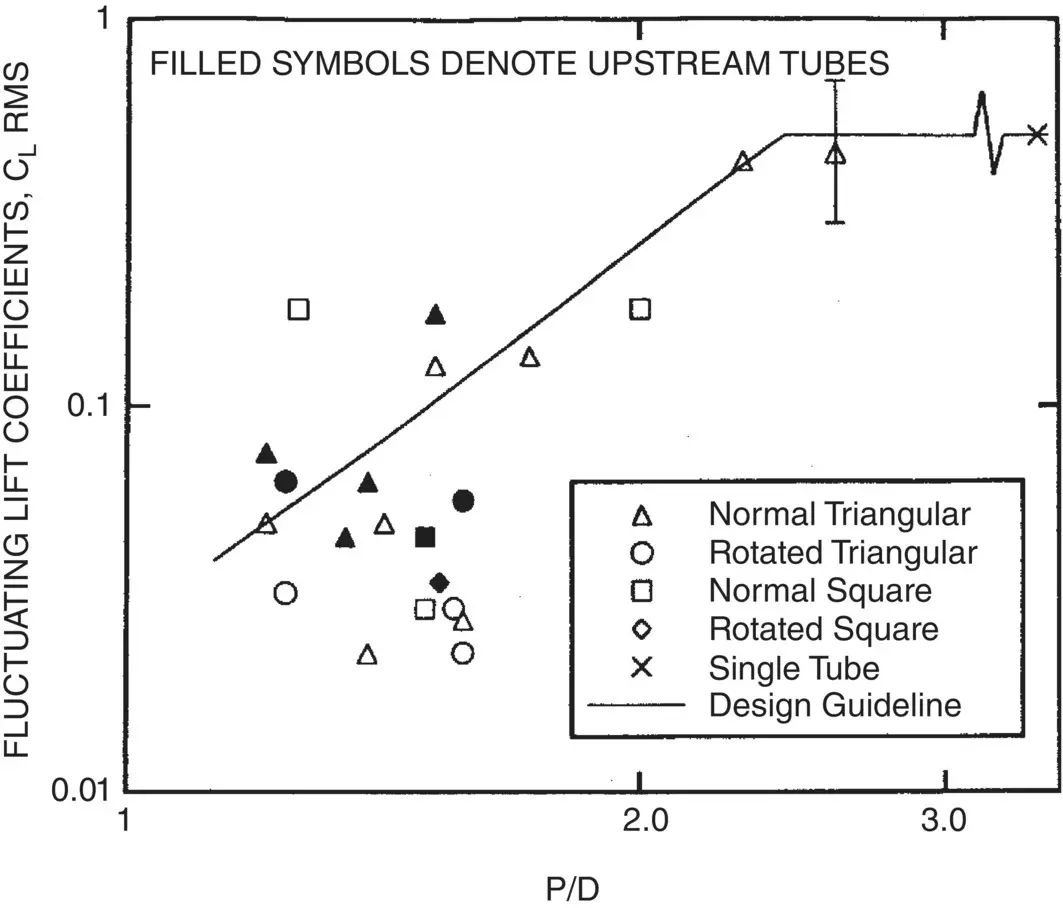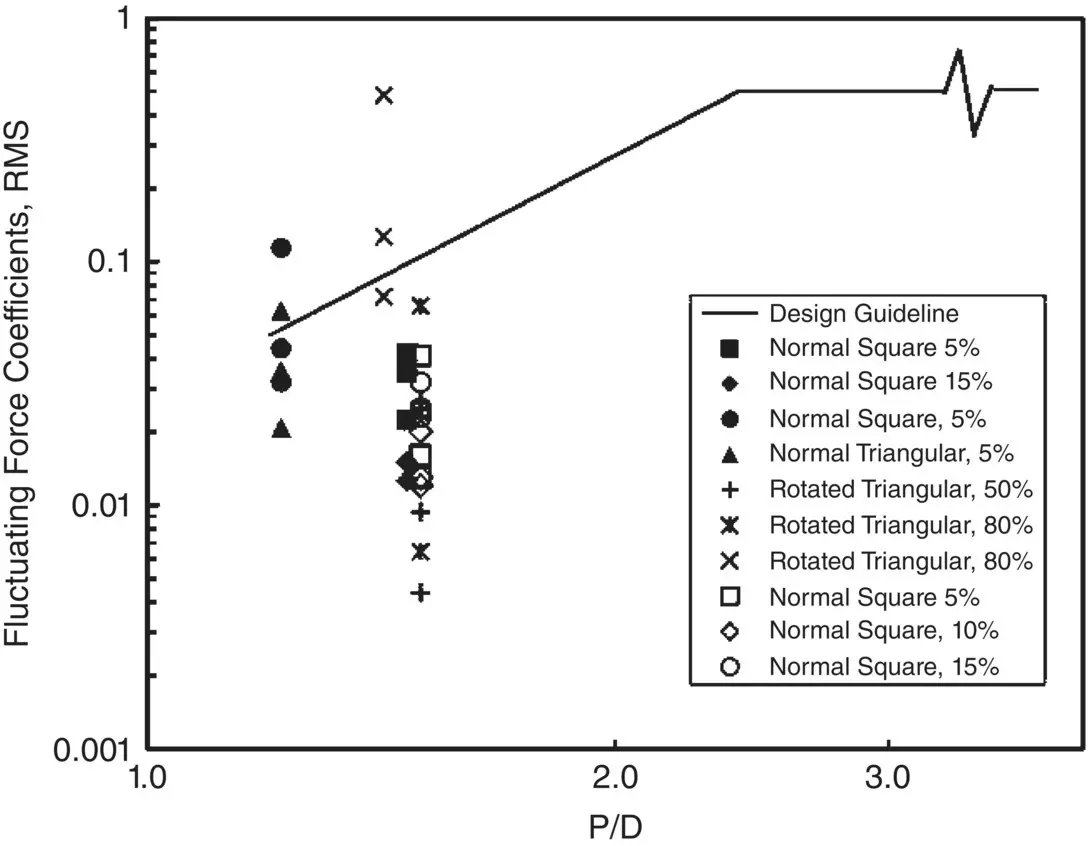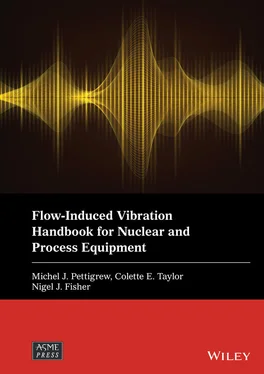for rotated‐triangular bundles, and
(2‐36c) 
for both normal‐ and rotated‐square bundles.
These expressions give Strouhal numbers between about 0.32 and 0.70 for realistic heat exchanger tube bundles of P/D between 1.23 and 1.57. These Strouhal numbers correspond to dimensionless pitch velocities, U p/ fD , between 1.5 and 3.0. Resonance should be assumed possible within this velocity range. In the case of a tube subjected to a non‐uniform velocity, only the fluctuating fluid forces corresponding to the region within the above range of dimensionless velocities need to be considered.
A review of the available data showed that fluctuating forces due to periodic wake shedding depend on several parameters such as bundle configuration, location within the bundle, Reynolds number, turbulence level, fluid density and P/D . At the limit when P/D is large, fluctuating force coefficients should approach those for single cylinders. On the other hand, when P/D is very small the force coefficients are small since the fluid mass associated with the formation of periodic wake or vortices is small as there is little space available within the bundle for large vortices.
The available data for fluctuating force coefficients in single‐ and two‐phase flow is compiled in Fig. 2-17and Fig. 2-18, respectively. In single‐phase flow, Fig. 2-17shows that the fluctuating lift coefficient, C L, is very dependent on P/D up to P / D ≈ 2.5. For both single‐ and two‐phase flow within heat exchanger tube bundles of P / D < 1.6, a fluctuating force coefficient of C L= 0.075 rms is recommended to calculate periodic‐wake‐shedding forces.
When resonance is considered possible, the maximum allowable tube vibration amplitude should not exceed 0.02 D or 2% of the tube diameter. Below 0.02 D , the vibration amplitude is generally not sufficient to correlate periodic wake shedding along the tube, resulting in much lower vibration response. If the vibration response exceeds 0.02 D , a fatigue analysis and a fretting‐wear damage calculation should be done, as outlined in Chapter 12.

Fig. 2-17 Fluctuating Force Coefficients for Tube Bundles in Single‐Phase Cross Flow. (Based on Weaver et al. 1987)

Fig. 2-18 Fluctuating Force Coefficients for Tube Bundles in Two‐Phase Cross Flow.
Acoustic resonance may take place in heat exchanger tube bundles when periodic‐wake‐shedding frequencies coincide with a natural frequency for acoustic standing waves within a heat exchanger cavity. The flow‐excited acoustic standing waves are generally transverse to both the axis of the tubes and to the direction of flow. Such resonances normally cause intense acoustic noise with sound pressure amplitudes that can exceed 160 dB. Tube, baffle and duct damage from fatigue may also occur, if nothing is done to eliminate the noise problem. Acoustic resonance is possible in gas heat exchangers with both finned and bare tubes.
Acoustic resonance requires two conditions: 1) coincidence of shedding and acoustic frequencies, and 2) sufficient acoustic energy to overcome the acoustic damping in order that sustained acoustic standing-wave resonance occurs.
An approach to acoustic resonance is given below. For more detail, refer to Chapter 11.
Frequency Estimates: As discussed earlier, periodic wake shedding is governed by the Strouhal number:
(2‐37) 
The Strouhal number may be obtained from Eq. (2‐36) or from Fig. 2-16for different tube bundle configurations and P/D ratios. The range of Strouhal numbers over which acoustic resonance can take place should be extended to allow for possible “lock‐in” of the wake. As suggested by Blevins and Bressler (1987), acoustic resonance may be possible between 0.8 S and 1.3 S , or in terms of periodic-wake-shedding frequency
(2‐38) 
Acoustic standing wave frequencies, f an, are defined by:
(2‐39) 
where W is the dimension of the heat exchanger tube bundle cavity in the direction normal to the flow and the tube axes, n is the mode order and C eis the effective speed of sound (Ziada et al, 1989):
(2‐40) 
The speed of sound, C , is obtained from
(2‐41) 
where k is the specific heat ratio ( k = 1.33 for steam), p is the shell side pressure and ρ is the shell-side fluid density.
The speed of sound is affected by the presence of the tubes. This effect is related to the solidity ratio, σ , which is the ratio of the volume occupied by the tubes over the volume of the tube bundle. For a triangular tube bundle
(2‐42a) 
and, for a square tube bundle
(2‐42b) 
The acoustic standing wave frequencies should be calculated for the first few acoustic modes (i.e., the first five modes should suffice). If one or more acoustic mode frequencies fall within the range of periodic‐wake‐shedding frequency, acoustic resonance conditions are possible.
2.4.5 Susceptibility to Resonance
Coincidence of acoustic and shedding frequencies does not necessarily cause resonance. Resonance also depends on acoustic energy and acoustic damping. Several design criteria have been proposed to evaluate susceptibility to tube bundle resonance. The design guidelines of Blevins and Bressler (1987) and of Ziada et al (1989) are suggested for heat exchanger tube bundles.
Blevins and Bressler (1987) suggest that resonance is less likely for closely packed tube bundles, probably because acoustic damping is higher. Also, closely packed tube bundles probably prevent the formation of larger vortices that are associated with higher acoustic energy. From experimental data for first‐mode acoustic resonance, Blevins and Bressler (1987) show that resonance is unlikely for P/D < 1.6 and L/D < 3.0 for staggered (triangular) tube bundles, and for L/D < 1.4 for in‐line (square) tube bundles. Here, P is the transverse pitch and L is the longitudinal pitch. However, they do not discuss the applicability of their criterion to higher‐order acoustic modes.
Читать дальше






















